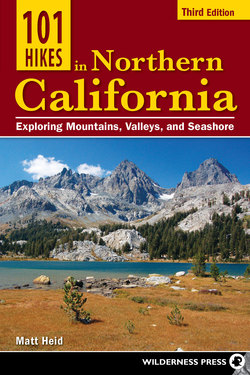Читать книгу 101 Hikes in Northern California - Matt Heid - Страница 22
На сайте Литреса книга снята с продажи.
ОглавлениеHIKE 5 Molera Beach
Highlight Peace and quiet on the beach
Distance 5.0 miles
Total Elevation Gain/Loss 200'/200'
Hiking Time 3–4 hours
Recommended Map USGS 7.5-min. Big Sur
Best Times September–May
Agency Andrew Molera State Park
Difficulty
FOR CONSTANTLY BEING by the ocean, there is remarkably little coastal access from Hwy. 1 on the Big Sur coast. The jagged rocks and sheer cliffs that make the region so spectacular also make finding a beach, much less a secluded beach, a difficult proposition. Luckily there is Andrew Molera State Park and its 2-mile-long stretch of sand, whose farther end offers an opportunity to escape the crowds and commune peacefully with the sea.
The Hike explores the length of Molera Beach, traveling to its end before returning along the low bluffs. This is a tide-dependent hike, and the beach is treacherous and impassable in places during high tides, making it necessary to walk along the bluffs during these times. Tide tables are usually posted on the information sign in the parking lot, or you can check at Big Sur Station before heading out. Those arriving around high tide should hike first along the bluffs and return along the beach closer to low tide. Due to the treacherous nature of ocean currents here, swimming is deemed unsafe. Be aware that the seasonal starting footbridge across Big Sur River is removed after the first heavy winter rains, making it necessary to ford the swollen river during the winter months. Water is available at the trailhead. Dogs are prohibited.
To Reach the Trailhead Take Hwy. 1 south of Carmel for 22 miles to the park entrance and substantial parking lot. Approaching from the south, the turnoff is 4.2 miles north of the park entrance for Pfeiffer Big Sur State Park and is a hard, dogleg left turn. There is a day-use fee of $10, valid for all Big Sur area state parks. It is possible to reach the trailhead by public transportation on Monterey-Salinas Transit Bus 22, which runs two to three times daily from downtown Monterey to Pfeiffer Big Sur State Park from Memorial Day to Labor Day, weekends only during the rest of the year. Call 888-678-2871 for current schedule and fare information, or visit mst.org.
Description From the trailhead, cross Big Sur River on the narrow footbridge and bear right on Beach Trail. Paralleling but beyond sight of the river, you pass the Creamery, a former pasture slowly being replanted with native vegetation. Twisted sycamores, arroyo willows, black cottonwood, red alders, and a few redwoods line the river, and chest-high bush lupines dot the open meadow. Looking behind you to the east, a prominent ridge of the Santa Lucia Range is visible. Composed primarily of granite transported from the south along the San Andreas Fault, the mountain range owes much of its sheer topography to the erosion-resistant nature of its granitic rock. The Creamery is also an excellent area for viewing birdlife—killdeer, black phoebes, and Cooper’s hawks can often be spotted.
Continuing toward the beach, notice the incredibly grizzled redwood tree across the meadow on your left before you turn back toward the river. Then pass thick patches of poison oak and coffeeberry, which is easily identified by the dark black berries that ripen in the fall. Driftwood shelters and other interesting constructs fill this first sandy area where you turn south and begin the beach walk.
The low bluffs along the beach expose the variegated hues of intensely deformed rocks. While part of the Franciscan Complex, they have been more heavily metamorphosed than similar exposures found farther north in California, as a result of the numerous northwest-trending faults associated with the San Andreas Fault, which slice apart the Big Sur region and intensely shear the adjacent rock. The rare mineral almondite is exposed in places, coloring the white sand purple where it has eroded onto the beach. Rounded granite stones are also present, washed down from the Santa Lucia Mountains.
Sea lions, seals, and even sea otters can sometimes be spotted offshore as you go (barefoot) up the beach. Crowds diminish and rocky points hem in secluded stretches of sand as you continue, eventually reaching the junction for Spring Trail, your access to the return route on the bluffs above.
Eighty feet of climbing up a narrow gully brings you to Bluff Trail—go left back the direction you came. Coyote brush, poison hemlock, California poppies, and more lupine cover the open blufftops along the trail back toward the Creamery. At the bluffs’ end, the trail intersects Ridge Trail—go left again, immediately dropping down to a wide dirt road. Bearing left here returns you to the Beach Trail. Turning right down the road takes you winding along the opposite side of the Creamery close to several large coast live oaks, before the road rejoins the Beach Trail at the footbridge over Big Sur River.
Relaxing on Molera Beach
Nearest Visitor Center Big Sur Station, 831-667-2315, 10 miles north of the entrance of Julia Pfeiffer Burns State Park and just south of Pfeiffer Big Sur State Park on Hwy. 1, is open daily 8 a.m.–6 p.m. Memorial Day–Labor Day; the rest of the year it’s open daily 8 a.m.–4:30 p.m.
Nearest Campgrounds Andrew Molera State Park has 24 walk-in campsites available in a large meadow near the Big Sur River on a first-come, first-served basis ($25 per site, register at the entrance kiosk, with a maximum of 4 people per site and no dogs allowed). The closest developed campground is Pfeiffer Big Sur State Park (200 sites, $35–$50, depending on site and time of year). Reservations are essential in the summer; visit reserveamerica.com or call 800-444-7275.
Additional Information www.parks.ca.gov
